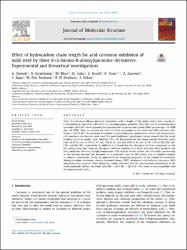| dc.contributor.author | Tazouti, A. | |
| dc.contributor.author | Errahmany, N. | |
| dc.contributor.author | Galai, M. | |
| dc.contributor.author | Rouifi, Z. | |
| dc.contributor.author | Zarrouk, A. | |
| dc.contributor.author | Kaya Savaş | |
| dc.contributor.author | Ebn Touhami, M. | |
| dc.contributor.author | El Ibrahimi, B. | |
| dc.contributor.author | Erkan Sultan | |
| dc.date.accessioned | 2022-05-17T06:15:26Z | |
| dc.date.available | 2022-05-17T06:15:26Z | |
| dc.date.issued | Kasım 2021 | tr |
| dc.identifier.citation | Tazouti, A., Errahmany, N., Rbaa, M., Galai, M., Rouifi, Z., Touir, R., ... & Erkan, S. (2021). Effect of hydrocarbon chain length for acid corrosion inhibition of mild steel by three 8-(n-bromo-R-alkoxy) quinoline derivatives: experimental and theoretical investigations. Journal of Molecular Structure, 1244, 130976. | tr |
| dc.identifier.uri | https://www.sciencedirect.com/science/article/pii/S002228602101108X#! | |
| dc.identifier.uri | https://hdl.handle.net/20.500.12418/13151 | |
| dc.description.abstract | Three 8-(n-bromo-R-alkoxy) quinoline derivatives with a length of the hydrocarbon chain, namely 8-(2-bromoethoxy) quinoline (QN-C2Br), 8-(3-bromopropoxy) quinoline (QN-C3Br) and 8-(4-bromobutoxy) quinoline (QN-C4Br) were prepared and characterized by proton and carbon NMR spectroscopy (1H NMR and 13C NMR). Thus, to evaluate the effect of these compounds on the mild steel (MS) corrosion inhibition in 1.0 M HCl, electrochemical methods of potentiodynamic polarization curves and electrochemical impedance spectroscopy were used. The potentiodynamic polarization curves showed that the tested products act as an anodic - type inhibitor. Thus, EIS designated that the charge transfer resistance arises from 32.41 Ω cm2 to 705.21 Ω cm2, 783.21 Ω cm2 and 1389.12 Ω cm2 at 10−3 M of QN-C2Br, QN-C3Br and QN-C4Br, respectively. In addition, it is found that the adsorption of three compounds on the MS surface obeys the Langmuir adsorption isotherm equation. It is found also that these products take their inhibition efficiency at high temperature. SEM analysis of the surface and UV-visible spectroscopy of the solution indicates the formation of a protective layer on MS surface and an inhibitor-complex in solution, respectively. Finally, to understand the adsorption properties of the studied 8-(n-bromo-R-alkoxy)quinolone derivatives, density functional theory (DFT) calculations and molecular dynamics (MD) simulation were achieved. These theoretical studies indicated that the anti-corrosion performance of the tested molecules follows the trend: QN-C4Br > QN-C3Br > QN-C2Br. This trend is very compatible with the experimental results. | tr |
| dc.language.iso | eng | tr |
| dc.publisher | Elsevier | tr |
| dc.relation.isversionof | 10.1016/j.molstruc.2021.130976 | tr |
| dc.rights | info:eu-repo/semantics/openAccess | tr |
| dc.subject | Length of the hydrocarbon chain effect8-(n-bromo-R-alkoxy)quinoline derivativesCorrosion inhibitionElectrochemical measurementsTheoretical investigations | tr |
| dc.title | Effect of hydrocarbon chain length for acid corrosion inhibition of mild steel by three 8-(n-bromo-R-alkoxy)quinoline derivatives: Experimental and theoretical investigations | tr |
| dc.type | article | tr |
| dc.relation.journal | Journal of Molecular Structure | tr |
| dc.contributor.department | Fen Fakültesi | tr |
| dc.contributor.authorID | 0000-0001-6744-929X | tr |
| dc.identifier.volume | 1244 | tr |
| dc.identifier.startpage | 130976 | tr |
| dc.relation.publicationcategory | Uluslararası Editör Denetimli Dergide Makale - Başka Kurum Yazarı | tr |















